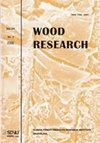树皮基活性炭对挥发性有机物和金属的吸附性能
IF 1
4区 农林科学
Q3 MATERIALS SCIENCE, PAPER & WOOD
引用次数: 0
摘要
本研究旨在研究树皮基活性炭(AC)吸附大气中金属离子和挥发性有机化合物(VOC)的适用性。用椰子壳制成的AC以及落叶松和软木橡树皮(分别为CSA、LBA和COA)中的Fe和Al含量高于未暴露AC,并且与未暴露AC相比,随着暴露于各种室内/室外空间而增加,低于且几乎不高于未暴露的SAA。从结果中可以明显看出,本研究中检测的树皮基AC比SAA更有效地吸附金属。SEM-EDS分析显示COA具有显著的金属吸附性,尽管其总表面积和孔体积低于SAA。总VOC吸附率在COA中最高,其次是CSA、CBA、LBA和SAA。总之,树皮基AC可以作为一种有效的吸附剂去除大气中的金属和VOC。从技术经济角度来看,最佳AC是工业副产品COA。本文章由计算机程序翻译,如有差异,请以英文原文为准。
VOLATILE ORGANIC COMPOUNDS AND METALS ADSORPTION CAPACITY OF WOOD BARK-BASED ACTIVATED CARBONS
This study was conducted to investigate the applicability of wood bark-based activated carbon (AC) for the adsorption of metal ions and volatile organic compounds (VOC) from the atmosphere. Contents of Fe and Al in the AC made with coconut shell, and the bark of larch and cork oak (CSA, LBA and COA, respectively) were higher than those of the unexposed AC and increased with the exposure to various indoor/outdoor spaces when compared to the unexposed AC. However, Fe and Al contents of the exposed AC, which is a coal-based one used as a control (SAA), were lower and scarcely higher than the unexposed SAA. From the results, it is evident that the wood bark-based AC examined in this study is more effective to adsorb metals than SAA. The SEM-EDS analysis exhibited prominent metal-adsorptivity of COA, although its total surface area and pore volume were lower than those of SAA. Total VOC-adsorptivity was the highest in COA followed by CSA, CBA (cypress bark activated carbon), LBA and SAA. In conclusion, wood bark-based AC can be utilized as an effective adsorbent for the removal of metals and VOC from the atmosphere. The optimum AC is COA, an industrial by-product, in view of the techno-economic aspect.
求助全文
通过发布文献求助,成功后即可免费获取论文全文。
去求助
来源期刊

Wood Research
工程技术-材料科学:纸与木材
CiteScore
2.40
自引率
15.40%
发文量
81
审稿时长
5.4 months
期刊介绍:
Wood Research publishes original papers aimed at recent advances in all branches of wood science (biology, chemistry, wood physics and mechanics, mechanical and chemical processing etc.). Submission of the manuscript implies that it has not been published before and it is not under consideration for publication elsewhere.
 求助内容:
求助内容: 应助结果提醒方式:
应助结果提醒方式:


